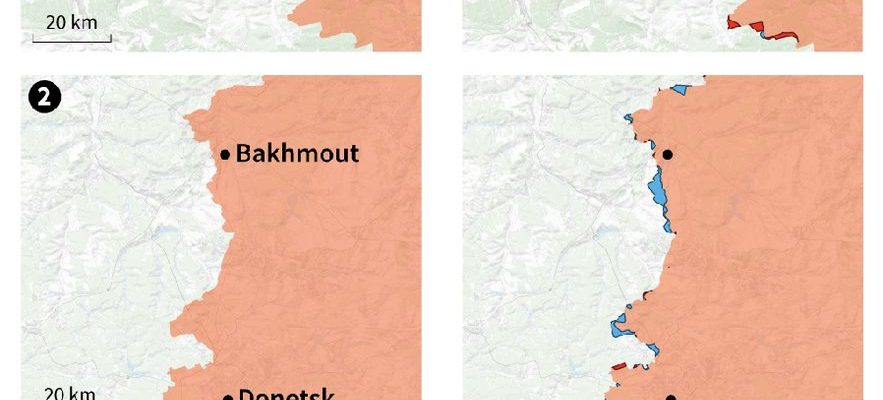These are the first signs of friction between Washington and kyiv. US officials are increasingly critical of Ukraine’s counteroffensive strategy, and gloomy about its prospects for success. This is reported the Financial Times (FT) and the washington post.
Contacted by the washington post, American intelligence estimates that the Ukrainian counter-offensive launched last June will not reach the key town of Melitopol, in the south-east of the country. If this conclusion turns out to be correct, it would mean that kyiv would not achieve its main objective: to cut off Russia’s land bridge to Crimea.
As the American daily reminds us, the city of Melitopol is essential to the counter-offensive because it is considered the gateway to Crimea. It lies at the intersection of two major highways and a railway line that allow Russia to move military personnel and equipment from the peninsula to other occupied territories in southern Ukraine.
Ukraine’s Slow Progress
During the first week of fighting in early June, Ukraine suffered heavy losses against well-prepared Russian defenses despite a range of newly acquired Western equipment, including US Bradley fighting vehicles, Leopard 2 tanks of German manufacture and specialized demining vehicles.
The United States and Ukraine had originally planned an offensive that would quickly push back the occupying Russian forces over the summer. But slow progress on the ground has prompted Kiev to revert to more traditional tactics rather than the joint maneuvers the United States and its Western allies taught them in Europe earlier this year, says the Financial Times.
Washington and kyiv differ on the tactics to be used on the front. US officials said at the Washington Post that the Pentagon had repeatedly recommended that Ukraine focus much of its forces on a single breakthrough point. But kyiv adopted a different strategy.
War in Ukraine: evolution since the beginning of the counter-offensive
© / afp.com/Nalini LEPETIT-CHELLA, Paz PIZARRO
The FT indicates for his part that the American officials have invited the Ukrainians to fully commit their forces to the main axis of the counter-offensive, in the south, so that they have a chance of penetrating the Russian lines to reach the sea of Azov, thus cutting off the Russian land bridge. But Ukraine has instead deployed some of its best combat units to the east of the country, in a battle to retake Bakhmout.
“Long, Bloody and Slow”
US officials are now privately preparing for what looks more and more like a war of attrition, which is expected to last until the year 2024. “I said a few months ago that this offensive was going to be long , bloody and slow,” said at the Washington Post Gen. Mark A. Milley, chairman of the Joint Chiefs of Staff. “And that’s exactly what it is: long, bloody and slow, and it’s a very, very tough fight.”
However, Washington publicly reiterates its support for kyiv. “We are doing everything we can to support Ukraine in its counter-offensive,” US national security adviser Jake Sullivan said on Friday. “We’re not going to handicap the outcome. We’re not going to predict what’s going to happen because this war is inherently unpredictable,” he said.
The day before, Ukrainian Foreign Minister Dmytro Kuleba acknowledged the slowness of the Ukrainian counter-offensive, but said kyiv would not stop fighting until all of its land was recaptured. “Our goal is victory, victory in the form of liberating our territories within the 1991 borders. And no matter how long that takes,” he told AFP.
A counter-offensive deemed “failed”
These difficult prospects for Ukraine herald turbulent political debates in the United States. As reminded the FT, the pessimism about the Ukrainian counteroffensive comes just weeks before the expiration of a $43 billion package of direct U.S. military aid for Ukraine. Given Ukraine’s modest results, some Republican officials are now reluctant to accede to President Joe Biden’s request to get Congress to vote for an additional $20.6 billion in aid to Kiev.
Republican Congressman Andy Harris, so far a strong supporter of military aid, is more reluctant. As reported by the FFinancial Timeshe told a town hall meeting in Maryland this week that the Ukrainian counteroffensive had “failed”. “I’ll be frank, it’s a miss,” he said. Other Republicans and, to a lesser extent, a few Democratic officials, meanwhile, have faulted the Biden administration for not sending more powerful weapons to Ukraine sooner.
Military aid revised downwards in 2024?
“A blockage or reduction in aid is unlikely, but a political battle is inevitable, given growing concerns on both left and right,” writes Mark Cancian, senior adviser at CSIS, a think tank for Washington, in a note published this week.
Even if Congress authorizes the latest funding package for Ukraine requested by the White House, some U.S. officials and analysts say Washington is unlikely to be able to offer the same level of military assistance to the Ukraine. Ukraine in 2024, particularly given the presidential campaign.
According to a CNN poll released in August, 55% of Americans now oppose increased congressional funding for Ukraine, while 45% support it. A big turnaround from the overwhelming support for Kyiv at the start of the conflict.
